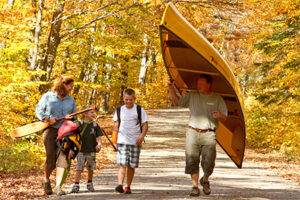Buying the Perfect Canoe
When considering purchasing the ideal canoe, there are two questions you must ask yourself: how are you going to use the canoe and how much are you willing to spend? By answering these two questions, you are more likely to purchase something that will make you happy.
Regarding how you are going to use your canoe, consider things like: Is it sitting on the dock ready for day paddles at the cottage? Or are you going to strap it to your roof and take it to different destinations? Is it for day trips or multi-day backcountry paddling? Are you paddling with kids and/or a big dog? Answering these types of questions will help you figure out the best canoe for your needs.
Let’s look at the basic canoe design to see how the design affects performance.
Length: The common length of a tripping canoe is 16 feet. A longer canoe is faster, has more carrying capacity and tracks better, meaning it keeps a straight line with less corrective strokes needed. The trade off is that longer canoes do not manoeuvre as easily. In my conversation with Carmen Baum, Marketing Manager of Swift Canoe and Kayak, she recommends day trippers buy a 15-foot canoe or shorter as unweighted, longer canoes will be more affected by the wind.
Beam or width: Wider canoes are more stable but less efficient. Typical beams are 33-36 inches.
Depth: A deeper canoe can carry more weight and rides well above the waterline but will be blown around more in windy conditions. Typical depth at the centre of the canoe is 13-14 inches.
Hull Profile: A cross section of the canoe’s hull will show you how it rests on the water. Flat bottomed canoes are stable and slow. Rounded bottoms are faster and feel more tippy. Commonly, most canoe manufacturers compromise and offer shallow arch or shallow vee designs which can be tweaked towards more stability or higher efficiency depending on the design.
Keel: Keels run the length of the canoe along the centre line and help the canoe track better, but they add more weight and reduce the turning ability of the canoe. If the canoe has three keels, it will be very stable, flat bottomed and sluggish. Most higher end canoes build good tracking into the design by sharpening the entry line at the bow and modifying the hull profile, eliminating the need for a keel.
Canoe Profile: Look at the canoe from the front or back. If the sides flair out, they will deflect more water but will be more tiring to paddle as your arms need to extend out further to reach the water. If they are curling in, a feature called tumblehome, the canoe will be more comfortable to paddle but will stand more chance of taking in water from waves. Straight sides are a compromise between the two. 
Step back and look how the canoe rests on a flat surface. If the ends of the canoe appear to ride up and not touch the ground, then the canoe has rocker. This feature will make the canoe more maneuverable needing more steering stokes to keep a straight line. The classic prospector design has a slight rocker.
Finally, the materials a canoe is made from will affect their weight, durability, and cost. Carbon fibre and Kevlar are light, strong, and expensive. Fiberglass is heavier, hardy, and less expensive. Many canoes are made from polyethylene, an inexpensive plastic product that can be heat-molded to any hull shape. They are very heavy and durable. White water canoes are usually made from composite materials that are both hardy and lighter than polyethylene.
Aluminum canoes are durable, loud to paddle, and are less expensive. Wood canoes, usually made with cedar and a variety of protective coverings are quiet and esthetically pleasing to paddle but need more maintenance and are more expensive as they are hand made. Sixteen-foot canoes can weigh anywhere from 35 to over 80 pounds depending on the construction materials.
There is much to consider when buying the ideal canoe. Reputable outfitters will be able to advise you on the best model for your needs, and many canoe shops are on water so you can paddle before buying. There are also some great deals in used canoes, but take the time to inform yourself before buying. Happy paddling!
Submitted by Rick Whitteker. You can find Rick at home in the forest, as a seasoned trail guide, nature writer and passionate wildlife enthusiast in the Haliburton Highlands.
Photo credits: Canoe on beach, canoes on rack – photo credit to Rick Reflective dock scene, family walking with canoe – Swift Canoe and Kayak.




